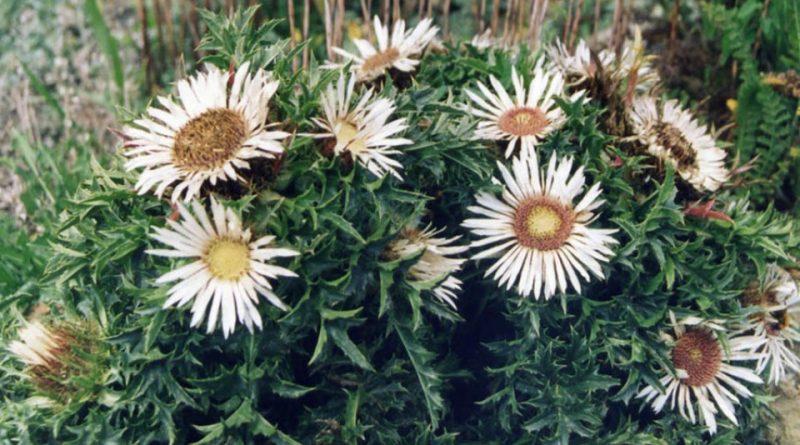Carlina acaulis subsp. simplex
Carlina acaulis subsp. simplex
The Carlina acaule (Carlina acaulis L. subsp. Simplex (Waldst. & Kit.) Nyman) is a perennial herbaceous species belonging to the Asteraceae family.
Systematic –
From a systematic point of view, it belongs to the Eukaryota Domain, Kingdom Plantae, Superdivision Spermatophyta, Division Magnoliophyta, Class Magnoliopsida, Subclass Asteridae, Order Asterales, Family Asteraceae, Subfamily Cichorioideae, Tribe Cardueae, Subtribu Carduinae and therefore to the Genus Carlina, to the Species C. acis. and to Subspecies C. a. simplex.
The terms are synonymous:
– Carlina simplex Waldst. & Kit .;
– Carlina acaulis L. subsp. caulescens (Lam.) Schübl. & M.Martens;
– Carlina acaulis subsp. aggregate.
Etymology –
The term Carlina of the genus was dedicated to Charlemagne; according to another hypothesis it is assumed that it is the diminutive of thistle, a plant very similar to the Carlina.
The specific epithet acaulis comes from the Greek privative prefix α- a- without and from καυλόϛ caulós stalk: acaule, without stalk.
The name simplex comes from simplex, -plicis simple, single, not complex: due to the presence of a short, undivided caule.
Geographical Distribution and Habitat –
The Carlina acaule is a plant that lives in the mountain environments of the European continent. In Italy it is present in the Alps and Prealps with an altitude distribution between 200 and 2100 meters above sea level.
The characteristic habitat is that of alpine meadows, pastures and arid meadows, edges, pine forests and junipers, preferably calcium-loving, xerophilous, spread from the mountain to the alpine plain.
Description –
The Carlina acaule has dimensions ranging from 10 to 40 cm and is very similar to the Carlina acaulis; this last one is distinguished by having a low stem (max 5 cm) and lobe teeth with a basal width of 2-6 mm.
According to some authors this characteristic has no taxonomic meaning.
The root is taproot.
The hypogean stem is absent while the epigean stem is erect and leafy.
The leaves are alternate petioles, hairless, with 10-20 (35) cm long spatulated leathery blade, seven-pinnate with 6-8 pairs of narrow segments, lobed (base 2-6 mm) and thorny.
The inflorescence has a single flower head, with a diameter of 3-4.5 cm, (with the involucral leaves up to 12) cylindrical envelope, linear thorny involucral leaves, radiant scales ivory-white, dark veined on the back (2-3 cm).
The flowers are actinomorphic, all tubular hermaphrodites with a purple corolla, cylindrical of 1.2-1.5 cm, stamens (inserted at the base) and yellow stigmas emerging from the corolline tube.
The antesis is between June and September.
The fruits are pubescent achenes with plumed pappus.
Cultivation –
The Carlina acaule is a spontaneous plant that is pollinated by insects, such as butterflies (also nocturnal) and bees (entomogamous pollination).
Fertilization takes place basically through the pollination of the flowers and the dispersion takes place with the seeds that fall to the ground (after being transported for a few meters by the wind thanks to the pappus – anemocora dissemination) are subsequently dispersed mainly by ants-like insects (myrmecoria dissemination ).
Uses and Traditions –
This subspecies is often confused with the species Cirsium acaule, from which it is distinguished by some vegetative characteristics.
The pre-flowering receptacles are edible and called, in the Alps, “hunters’ bread”.
The roots of this species are used for medicinal purposes.
Method of Preparation –
This species was used above all for its roots, for medicinal purposes, while the young receptacles are edible.
Guido Bissanti
Sources
– Acta Plantarum – Flora of the Italian Regions.
– Wikipedia, the free encyclopedia.
– Treben M., 2000. Health from the Lord’s Pharmacy, Tips and experiences with medicinal herbs, Ennsthaler Editore
– Pignatti S., 1982. Flora of Italy, Edagricole, Bologna.
– Conti F., Abbate G., Alessandrini A., Blasi C. (edited by), 2005. An annotated checklist of the Italian vascular flora, Palombi Editore.
Warning: Pharmaceutical applications and alimurgical uses are indicated for information purposes only, they do not in any way represent a medical prescription; therefore, no responsibility is accepted for their use for healing, aesthetic or food purposes.


